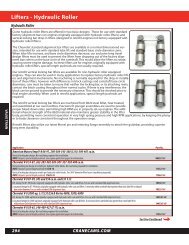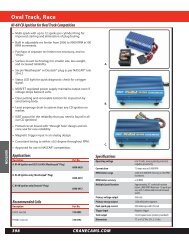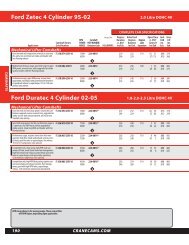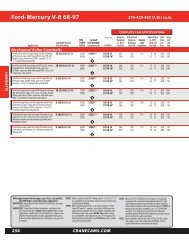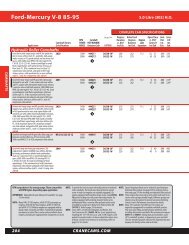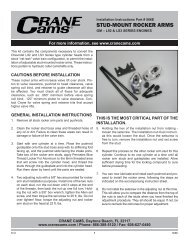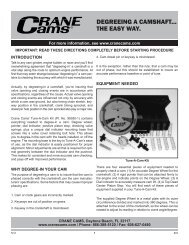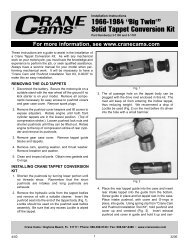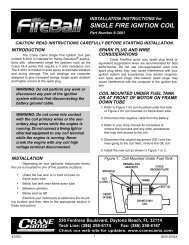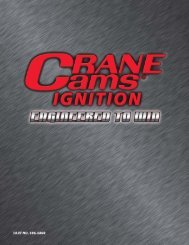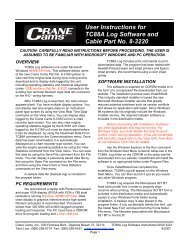2011 - Crane Cams
2011 - Crane Cams
2011 - Crane Cams
Create successful ePaper yourself
Turn your PDF publications into a flip-book with our unique Google optimized e-Paper software.
VALVE TRAIN<br />
Cam and Valve Train Questions<br />
Commonly Asked Valve Train Questions (continued)<br />
How does Cylinder Pressure relate to the octane rating of<br />
today’s unleaded fuel?<br />
In very basic terms, the more cylinder pressure we make the<br />
more power the engine will produce. But look out for the<br />
fuel! Today’s pump gasoline cannot tolerate excessive cylinder<br />
pressures. About 165 PSI with iron cylinder heads and<br />
180 PSI with aluminum cylinder heads are reasonable limits<br />
to adhere to. Remember, cylinder pressure is affected by the<br />
static compression ratio and the camshaft specifications<br />
(primarily the intake valve closing event). Excessive pressures<br />
will cause detonation, resulting in internal engine<br />
damage. Octane boosters, or a racing grade of fuel, may be<br />
required to avoid difficulties.<br />
How does an increase in Rocker Arm Ratio improve the<br />
engine’s performance?<br />
The lobe lift of the cam is increased by the ratio of the rocker<br />
arm to produce the final amount of valve lift. A cam with<br />
a .320” lobe lift using a 1.50:1 ratio rocker arm will have .480”<br />
valve lift (.320” x 1.50 = .480”). If you install rocker arms with<br />
an increased ratio of 1.60:1, with the same cam, the lift<br />
would increase to .512” (.320” x 1.60 = .512”). The engine<br />
reacts to the movement of the valve. It doesn’t know how<br />
the increased lift was generated. It responds the same way<br />
it would as if a slightly larger lift cam had been installed. In<br />
fact, since the speed of the valve is increased with the higher<br />
rocker arm ratio, the engine thinks it has also gained 2° to<br />
4° of camshaft duration. The end result is an easy and quick<br />
way to improve the performance of the existing cam without<br />
having to install a new one. See the Buyers Guide section<br />
for availability of increased ratio rocker arms.<br />
Remember, whenever you increase the valve lift, with either<br />
a bigger cam or larger rocker arm ratio, you must check for<br />
valve spring coil bind and for other mechanical interference.<br />
Please review the previous sections concerning these matters.<br />
Must new (Standard Design) lifters always be installed on<br />
a new camshaft?<br />
YES! All new standard (flat-faced) hydraulic and mechanical<br />
camshafts must have new lifters installed. The face of these<br />
lifters do have a slight crown, and the mating lobe surface<br />
they ride on has been ground with a slight taper. The purpose<br />
of this is to create a “spinning” of the lifter as it rides on<br />
the lobe. This is necessary to prevent premature wear of the<br />
lifter and lobe. Therefore, these parts will be mated to one<br />
another during the initial break-in period. Used lifters will<br />
not mate properly, causing the lobe to fail.<br />
If you are rebuilding an engine and plan to re-use the existing<br />
cam and lifters (in the same block) it can be done, as<br />
long as the lifter goes back on the same lobe it is mated to.<br />
To keep your components in order, a <strong>Crane</strong> <strong>Cams</strong> “Organizer<br />
Tray” part no. 99015-1 would be helpful. If the lifters get<br />
mixed up, they cannot be used, and a new set will be<br />
required. The new lifters would also have to go through the<br />
break-in procedure to mate to the old cam.<br />
380<br />
CRANECAMS.COM<br />
Can used Roller Lifters be installed on a new camshaft?<br />
YES. Roller lifters are the only ones that can be re-used. This<br />
design lifter has a wheel (supported by needle bearings)<br />
attached to the bottom of it. The lobe the roller lifter rides<br />
on does not have any taper. This is a very low friction design<br />
and does not require the lifter to mate to the cam. As long<br />
as the wheel shows no wear, and the needle bearings are in<br />
good condition, the hydraulic roller or mechanical roller lifter<br />
can be re-used.<br />
What Engine Oil and Lubricants should I use?<br />
<strong>Crane</strong> <strong>Cams</strong> does not recommend the use of synthetic oils<br />
during the initial break-in period for a new camshaft. Use a<br />
good quality grade of naturally formulated motor oil during<br />
this period. If you choose to use synthetic oil after the<br />
engine has been broken in, change the oil filter and follow<br />
the oil manufacturer’s instructions.<br />
When using either regular oil or synthetic it is important to<br />
pick the weight oil that best matches your engine bearing<br />
clearances, the engine’s operating temperature, and the climate<br />
the vehicle will be operating in. Use the oil manufacturer’s<br />
recommendation to satisfy these conditions.<br />
<strong>Crane</strong> <strong>Cams</strong> offers lubricants to aid during the critical breakin<br />
procedure, and to prolong the engine’s life. See the<br />
Buyers Guide section, page 303, for specific information on<br />
<strong>Crane</strong> <strong>Cams</strong> Lubricants and their application.<br />
Should I use Oil Restrictors in my engine?<br />
No, <strong>Crane</strong> <strong>Cams</strong> does not recommend the use of oil restrictors.<br />
The oil is the life blood of the engine, not only lubricating<br />
but cooling the engine components as well. For example,<br />
a valve spring builds in temperature as it compresses<br />
and relaxes. This increase of temperature affects the characteristics<br />
of the spring material, and if excessive, will shorten<br />
the life of the spring. Oil is the only means the spring has for<br />
cooling.<br />
How do I prime the engine’s oiling system?<br />
It is critical that the engine’s oiling system be primed before<br />
starting the newly built, or rebuilt, engine for the first time.<br />
This must be done by turning the oil pump with a drill<br />
motor to supply oil throughout the engine. If this is done<br />
with the valve covers off, you will be able to see that the oil<br />
is being delivered to the top of the engine and to all the<br />
valve train components. <strong>Crane</strong> <strong>Cams</strong> offers oil pump primers<br />
for Chevrolet and Ford engines, see page 331.<br />
What is the Most Important thing to remember?<br />
Reading and following the instructions supplied to you is<br />
most important. If there is something you don’t understand,<br />
contact the people who supplied you the parts, or call one<br />
of the <strong>Crane</strong> <strong>Cams</strong> Technical Consultants. Get answers to<br />
your questions before proceeding.<br />
Any non-roller camshaft and lifters must be pre-lubricated<br />
before installation. Use <strong>Crane</strong> <strong>Cams</strong> Assembly Lube, part<br />
number 99002-1, and <strong>Crane</strong> <strong>Cams</strong> Super-Lube, part number<br />
99003-1.



